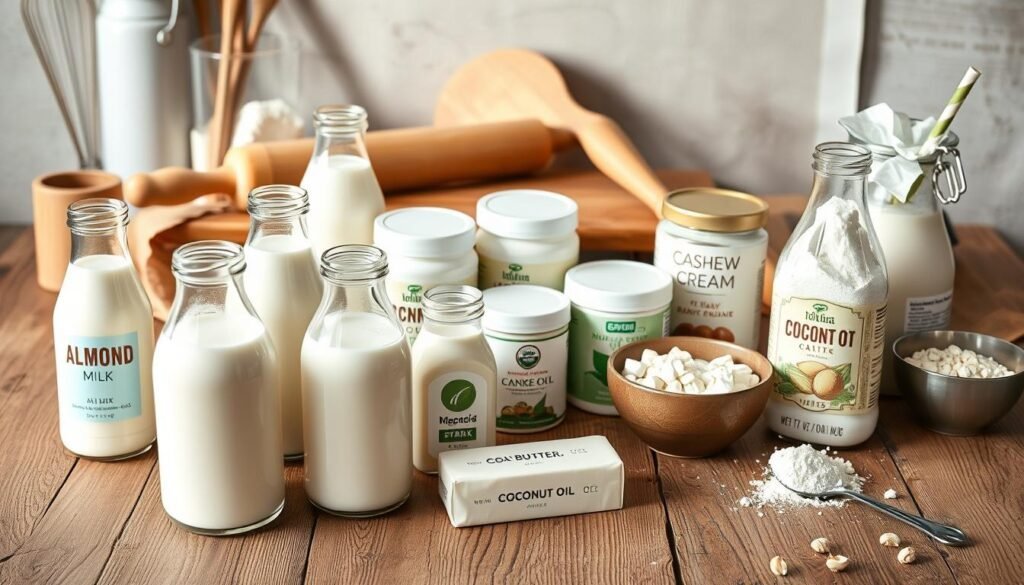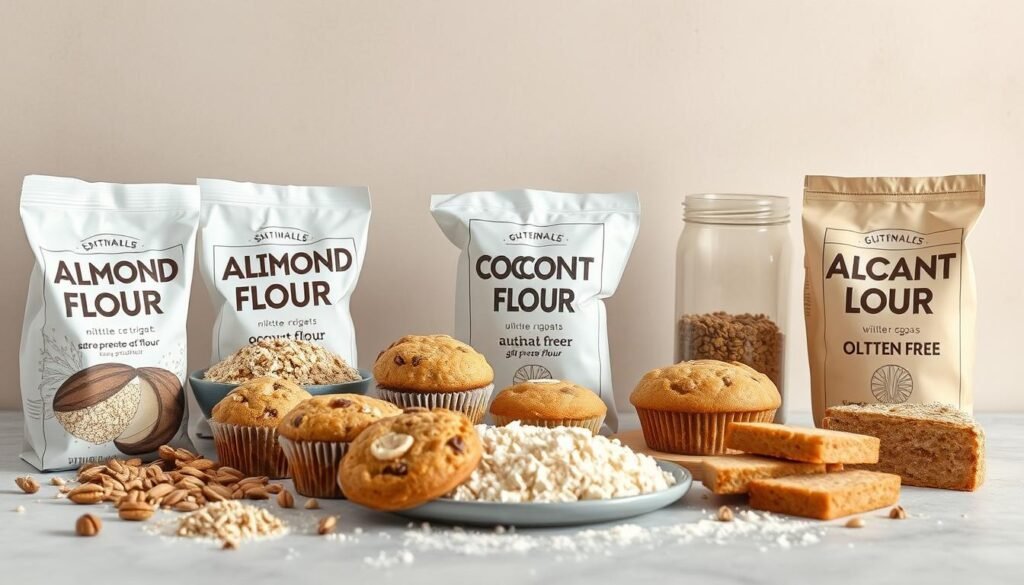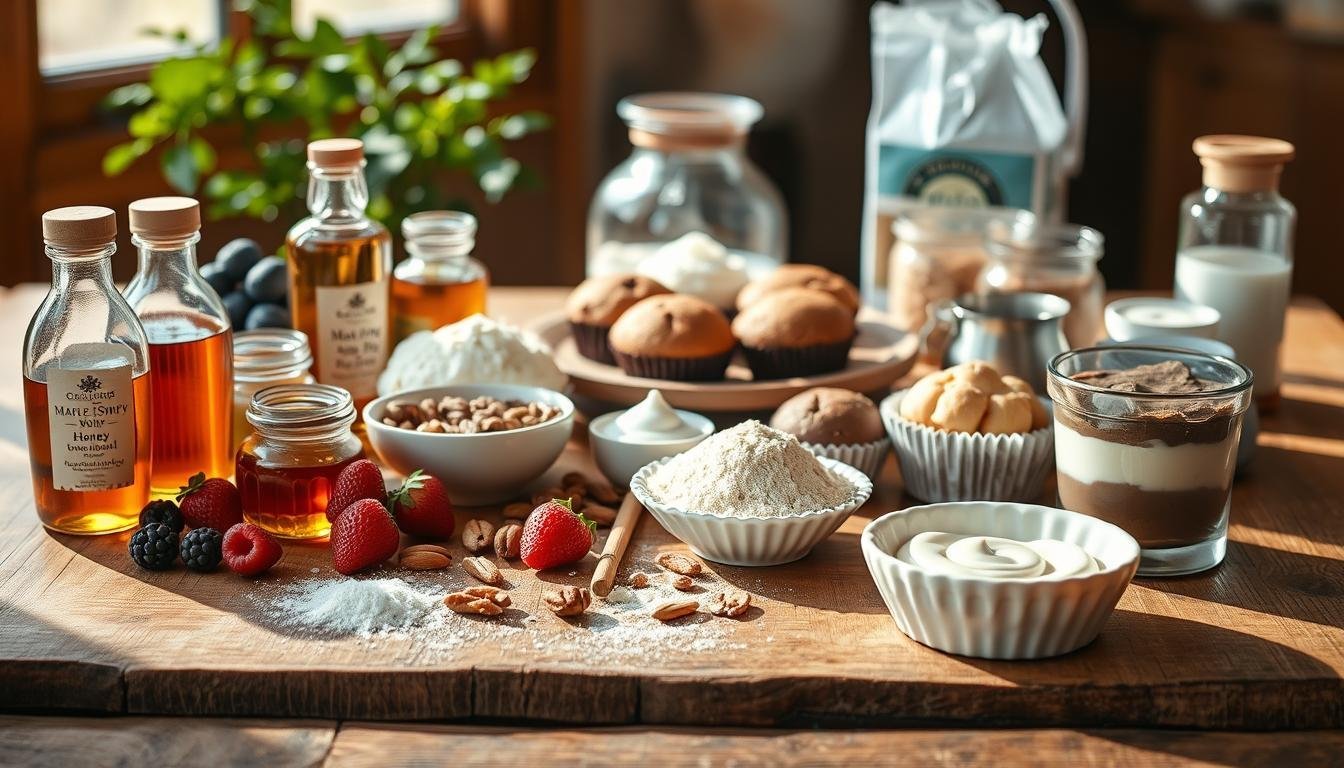Disclosure: This Post Contains Affiliate Links; We earn a commission on purchases.
Changing dessert recipes to fit different tastes and diets can be tough. You might want to make your desserts more welcoming or just use what you have. Knowing dessert substitutions is very important.
Many bakers find substituting ingredients scary. But, with a few simple changes, you can alter your favorite recipes. This guide will show you how to make easy dessert swaps, from swapping dairy to sugars.
For more info on substituting ingredients, check out Allrecipes. They have a detailed list of common swaps.
Key Takeaways
- Learn the basics of dessert ingredient substitutions.
- Find out how to swap dairy and sugars.
- Discover simple swaps for common ingredients.
- Make your desserts inclusive for guests with dietary needs.
- Get creative with what you already have.
Understanding the Art of Dessert Substitutions
Dessert ingredient swaps need careful thought to work well. Knowing what each ingredient does is key to making good swaps.
Why Ingredient Substitutions Matter
Substitutions are important because they help bakers meet dietary needs. They also let bakers use what they have and try new tastes. This makes desserts more fun and welcoming for everyone.
Basic Principles for Successful Swaps
Good swaps depend on knowing how ingredients work together. Key principles include keeping the right mix of fats, sugars, and leavening. This knowledge helps bakers make smart choices.
How Substitutions Affect Texture and Flavor
Swapping ingredients can change how desserts feel and taste. For instance, using oil instead of butter can change moisture levels. Honey instead of sugar can change flavors. Knowing these changes is key to getting the results you want.
Essential Dairy Substitutions for Baking Success
More people want dairy-free baked goods. Learning to replace dairy is key. Dairy adds moisture, texture, and flavor to baked goods. But, some people can’t or don’t want to use dairy.
Milk Alternatives and Their Unique Properties
Milk alternatives are getting more popular. They help those who avoid dairy. Plant-based milks like almond, soy, and oat milk are common choices.
Plant-Based Milk Options
Plant-based milks come in different flavors and textures. Almond milk is light, while soy milk tastes stronger.
Adjusting Recipes for Non-Dairy Milks
When using non-dairy milks, recipes need changes. Some milks might need extra thickeners for the right consistency.
Cream, Yogurt, and Buttermilk Replacements
Replacing cream, yogurt, and buttermilk needs some knowledge. Coconut cream works as heavy cream substitute. Non-dairy yogurts give a tangy taste like traditional yogurt.
Cheese Substitutes for Desserts
For desserts needing cheese, like cheesecakes, there are options. Vegan cream cheese or cashew-based mixtures can mimic cheese’s texture and taste.

Sweet Alternatives: Complete Sugar Substitution Guide
Many bakers want to use less sugar. Sugar is key in desserts for sweetness, texture, and color. But, some bakers choose substitutes for health reasons or taste. Knowing how to use these can make desserts healthier or taste better.
Natural Liquid Sweeteners
Natural liquid sweeteners are great sugar substitutes. They add sweetness and unique tastes to desserts.
Honey, Maple Syrup, and Agave Nectar
Honey, maple syrup, and agave nectar are favorites. Honey tastes like caramel, maple syrup is earthy, and agave is mild. They all make desserts special.
Conversion Ratios for Liquid Sweeteners
When using liquid sweeteners, adjust the amount. 1 cup of sugar is about 3/4 cup of honey or maple syrup. Use 2/3 cup of agave nectar. You might need to change the liquid in the recipe too.
Granulated Sugar Alternatives
For a traditional feel, try coconut sugar, date sugar, or monk fruit sweetener. Coconut sugar is like brown sugar and can be used the same amount. Date sugar is sweet and adds flavor. Monk fruit sweetener is very sweet, so use a little.
Fruit-Based Sweetening Methods
Fruit purees or cooked fruit sweeten desserts naturally. Applesauce or bananas replace sugar, adding moisture and taste. 
Using these sugar substitutes makes desserts tasty and healthy. Try different ones to find the right sweetness and flavor for your recipes.
Flour and Grain Substitutions for Every Dietary Need
Learning about flour and grain swaps can open up new dessert options. It lets you make treats for all kinds of diets and tastes. Flour is key in baking, and finding the right swaps keeps your desserts tasty and welcoming.
Gluten-Free Flour Blends and Ratios
Creating gluten-free flour mixes needs knowing about different flours. A mix might have rice flour, potato starch, and tapioca flour. Finding the right mix of these can change the dessert’s texture and taste.
For example, more rice flour makes desserts light. Potato starch helps them stick together better.
Nut and Seed Flours in Desserts
Nut and seed flours are great for those who can’t have gluten. They add a nutty taste. Almond flour, for instance, makes desserts moist and dense.
But, it’s very fatty. So, it changes how the dessert feels. Seed flours, like sunflower, add depth but in small amounts.
Grain-Free Baking Foundations
Grain-free baking uses flours from roots, nuts, or seeds. Coconut and cassava flours are favorites. Coconut flour soaks up a lot of liquid, so you need to add more to your recipe.
Coconut and Cassava Flour Tips
When using coconut flour, add a lot more liquid. Cassava flour can replace regular flour 1:1 in many cases. But, you might need a bit more fat for the right feel.
Binding Agents for Grain-Free Recipes
Grain-free recipes often need extra help to stick together. Eggs, xanthan gum, or guar gum can help. Try different combinations to get the right texture.

With these flour and grain swaps, bakers can make desserts for everyone. This way, everyone can enjoy a sweet treat.
Beginner’s Guide to Dessert Ingredient Substitutions for Eggs
Eggs are key in baking, adding structure, moisture, and leavening. Replacing them is both important and tricky.
Plant-Based Egg Replacers for Different Functions
Plant-based egg replacers are great for many desserts. Flaxseed meal mixed with water is a top choice for binding. Chia seeds also bind well when mixed with water.
Baking soda and vinegar or cream of tartar help desserts rise. They’re perfect for leavening.
Fruit and Vegetable Purees as Egg Substitutes
Fruit and vegetable purees can replace eggs in many desserts. They add moisture and sweetness. Mashed banana and applesauce are great in cakes and muffins.
These purees not only replace eggs but also improve flavor and texture.
Commercial Egg Alternatives and When to Use Them
Commercial egg alternatives are easy to use. Products like Ener-G Egg Replacer mimic eggs’ binding properties. They’re best in recipes where eggs are essential, like meringues or custards.
Mastering Butter and Fat Substitution Techniques
Learning to swap out butter and fats is key for making desserts for different diets. These ingredients greatly affect a dessert’s taste and texture. So, substituting them carefully is important.
Plant-Based Butter Alternatives for Baking
Plant-based butters are now a hit for baking. Brands like Earth Balance and Miyoko’s Kitchen Cultured Vegan Butter work like regular butter. But, always check the ingredients to ensure they won’t change your dessert’s taste.
Oil Substitutions with Proper Ratios
Switching oils in desserts needs knowing the different oils and their tastes. Neutral-tasting oils like canola or grapeseed can be used 1:1. But, flavored oils like coconut or olive oil need more thought because of their strong tastes.
Neutral vs. Flavored Oils
Neutral oils are best for desserts where you don’t want the oil’s taste to stand out. On the other hand, flavored oils like coconut can really boost a dessert’s flavor.
Solid vs. Liquid Fat Conversions
Switching between solid and liquid fats needs knowing their differences. If you swap solid fats like butter for liquid fats like oil, use about 25% less oil. This helps avoid desserts that are too wet.
Reducing Fat While Maintaining Moisture
To cut down on fat in desserts but keep them moist, try using applesauce, mashed banana, or yogurt. These ingredients cut down fat but add moisture and flavor. They’re a clever simple dessert hack.
Essential Flavor Enhancers and Specialty Ingredient Swaps
Make your baking better with our guide on flavor enhancers and swaps. Vanilla, chocolate, and spices are key, but you might need to swap them for different tastes or diets.
Vanilla and Extract Alternatives
Vanilla is a must in many sweets, but you can try almond extract, lemon zest, or bourbon vanilla for something new. Pick an alternative that fits your dessert’s flavor.
Chocolate and Cocoa Substitution Guide
Chocolate fans might find it hard to swap chocolate or cocoa. Cocoa powder can be swapped with carob powder or unsweetened cocoa nibs. For chocolate chips or chunks, think about chocolate chunks from dairy-free chocolate or cacao nibs.
Spice and Flavor Replacement Chart
Spices and flavors change how your desserts taste. Here’s a chart to help you swap common ones:
- Cinnamon: Try nutmeg or cardamom instead
- Nutmeg: Swap it with cinnamon or allspice
- Ginger: Use ground ginger or crystallized ginger instead
Conclusion: Building Confidence with Dessert Substitutions
Learning to swap out dessert ingredients is a key skill for bakers. It lets them make many desserts for different tastes and diets. This guide has shown how to do it easily.
This guide has covered many swaps, like for dairy, sugar, flour, and fats. It helps bakers try new recipes and ingredients. This way, they can grow their baking skills.
With this knowledge, bakers can make desserts that everyone can enjoy. It doesn’t matter if you’re new or experienced. Knowing how to swap ingredients makes your baking better.
FAQ
What are some common dairy substitutions in desserts?
How do I substitute sugar in my dessert recipes?
What are some gluten-free flour blends I can use in desserts?
How can I replace eggs in dessert recipes?
What are some plant-based butter alternatives for baking?
How do I substitute chocolate and cocoa in dessert recipes?
Can I reduce fat in dessert recipes without affecting texture?
What are some common spice and flavor replacements in desserts?

From beginner-friendly tips to no-fuss dessert ideas, Ryan is all about helping people enjoy baking and treat-making without the stress. Whether you’re whipping up something for a party or just craving something sweet, Ryan’s practical approach makes it easy to create desserts that taste great and don’t take all day.
Subscribe to Our Newsletter







